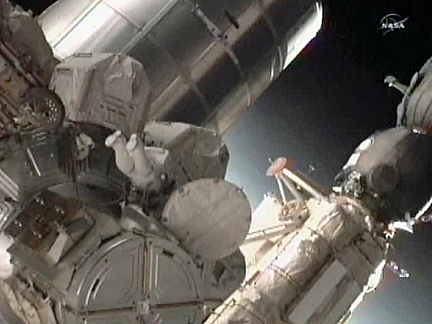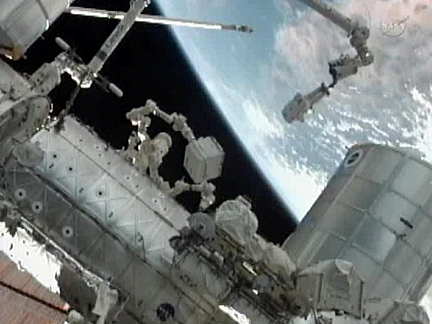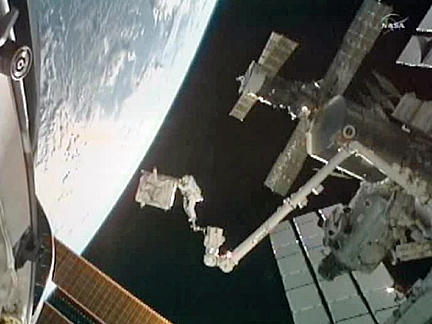Realtime coverage of STS-135 EVA-1
By WILLIAM HARWOOD
CBS News
04:10 PM EDT, 07/12/11: Spacewalk ends; all objectives accomplished
After accomplishing their two primary objectives -- moving a failed cooling pump from the station to the shuttle Atlantis and a robotic refueling apparatus from the shuttle to the lab complex -- astronauts Michael Fossum and Ronald Garan installed a materials science experiment on the station's power truss, serviced a robot arm attachment fitting and installed a thermal cover over an unused docking port.
The astronauts then made their way back to the lab's Quest airlock module, closed the hatch and began repressurizing at 3:53 p.m. EDT (GMT-4), officially ending a six-hour 31-minute spacewalk, the final excursion of the space shuttle era.
"You guys did an outstanding job today," spacewalk coordinator Rex Walheim radioed from Atlantis' flight deck a few minutes earlier. "You got everything done plus one bonus task and you're finishing perfectly on time."
Today's spacewalk was the 160th devoted to space station assembly and maintenance, the ninth so far this year, the seventh for Fossum and the fourth for Garan. Total space station EVA time now stands at 1,009 hours and nine minutes, or 42 days. Fossum, with 48 hours and 32 minutes of EVA time, moves up to seventh on the list of most experienced spacewalkers while Garan's total increases to 27 hours and three minutes.
Because Atlantis was launched with a reduced crew of four to accommodate possible rescue scenarios, today's spacewalk was carried out by station flight engineers Garan and Fossum to reduce training time for the shuttle crew. As such, the EVA was considered an Expedition 28 spacewalk, but it was the final outing by any astronauts with a space shuttle in orbit.
"I remember back when this space station was being designed and redesigned in '93 and '94, all of these tasks, the assembly tasks, the expected maintenance tasks and all of those things were starting to take shape and we looked at the future of EVA and compared it to our past history, starting with Gemini, through Apollo, Skylab, the early days of the shuttle program," Fossum reflected.
Considering the number of spacewalks required to build the International Space Station, "we called it the EVA 'wall,' because on the charts, that's what it looked like," Fossum said. "We had to learn a lot, and this has been accomplished by literally tens of thousands of people around the country and around the world who figured these things out. It is hard work. It's hard work on the ground, it's hard work by everybody involved. And it's really strange, and you don't get to test it much. You try things out for the first time in the real environment of space, and it's hard, it has been all the way along.
"But for those of us who were working the program back in those days, to see that we've really done it, it's just awe inspiring," he said. "It's a true testament to will power, perseverance and trust and teamwork. Ron and I are honored to be a part of it, to help close out one of the final chapters."
12:55 PM EDT, 07/12/11 Update: Robotic refueling apparatus mounted on space station
Taking his turn on the end of the space station's robot arm, astronaut Michael Fossum carried a 550-pound robotic refueling kit from the shuttle Atlantis to a mounting platform on the International Space Station to accomplish the second major objective of today's spacewalk.
The refueling kit will be used by a Canadian-built robot arm appendage known as the special purpose dexterous manipulator, or SPDM, to test techniques for robotic fueling of satellites and other equipment. While Fossum was carrying the module to the station, Garan cleaned up tools and equipment in the shuttle's cargo bay.
"Take a look around, Ronny," spacewalk coordinator Rex Walheim radioed from Atlantis' cockpit. "You're the last EVA person (spacewalker) in the payload bay of a shuttle."
A few minutes later, Garan headed back up to the station to join Fossum.
"Rex, as I leave for the last time, I want to tell you how much I appreciate all the thousands of people who worked on this vehicle," Garan said. "It is really beautiful back here."
"Yeah, it's an amazing vehicle, isn't it?" Walheim agreed.
Earlier in the spacewalk, the astronauts moved a failed pump module from the station to Atlantis so it can be returned to Earth for troubleshooting. With the robotics kit in place, Fossum and Garan now plan to install a materials science experiment before tackling a few maintenance chores.
11:50 AM EDT, 07/12/11 Update: Failed pump module moved to shuttle cargo bay
Anchored to the end of the space station's robot arm, astronaut Ronald Garan pulled a 1,400-pound ammonia coolant pump from a storage rack on the lab complex and manually held it in place as arm operators Sandra Magnus and Douglas Hurley carefully maneuvered him to the shuttle Atlantis' payload bay.
The pump module failed last July, taking down half of the International Space Station's external cooling system, which uses ammonia circulating through giant radiators to get rid of the heat generated by the lab's electronics. The failure forced the crew to carry out an emergency powerdown until a replacement could be installed and hooked up during three subsequent spacewalks.
Getting the failed pump back to Earth for analysis is a top priority and today, Garan and fellow spacewalker Michael Fossum started that process, moving the bulky module from a storage shelf near the station's airlock to a carrier beam at the back of Atlantis' cargo bay. Taking their time, the spacewalkers carefully maneuvered the pump away from other components before a spectacular robot arm ride to the shuttle.
"Ronny, can you control it?" Fossum asked, after releasing the bolt holding it the pump module in place.
"Yep."
"OK, I'm letting loose of it," Fossum said. "This end is pitching down... that's good, if you can pitch my end more zenith, that would better. You've got about 10 inches of clearance over that ORU, positive clearance, but it's not a lot. There you go, that's a lot better. It looks very stable. Doug, no more zenith required."
"Copy, starboard only," replied robot arm operator Douglas Hurley.
"I'm taking eyes off for a moment," Fossum said.
"OK," Garan said.
"It was pitching down on this end," Fossum said. "You've gotta maintain it. If you need a pitch back, Ron, they can give you that."
"Um, that might not be a bad idea."
"You're almost clear, guys, so if you can just hold it for a few more seconds, I think we'll be fine," Hurley said.
After rotating the pump 180 degrees, Garan held it in place while Hurley moved him down to Atlantis' cargo bay. Fossum met him there to begin the process of bolting it in place.
"How you doing, Ronnie?" spacewalk coordinator Rex Walheim radioed from the cockpit as the robot arm swept through a large arc.
"Doing great."
Spectacular video from the station showed Garan on the end of the arm above the limb of the Earth, dwarfed by the station and the immensity of space.
"Kind of like you're hanging off the edge of the world, isn't it?" Walheim radioed a few moments later.
"Yeah, it is," Garan agreed.
A few moments later, around 11:34 a.m. EDT (GMT-4), Garan and Fossum successfully bolted the pump module in place to complete the first primary task of today's spacewalk.
09:25 AM EDT, 07/12/11 Update: Spacewalk begins
Floating in the International Space Station's Quest airlock compartment, astronauts Michael Fossum and Ronald Garan switched their spacesuits to battery power at 9:22 a.m. EDT (GMT-4) to officially kick off a planned six-and-a-.half-hour spacewalk.
"Ronny, you ready to rock and roll?" Fossum asked before floating out of the airlock.
"Ready to rock and roll," Garan replied.
"Let's go, buddy."
Fossum and Garan plan to accomplish their primary goal first, moving a failed ammonia pump module from a storage platform just outside the airlock to a carrier in the shuttle Atlantis' cargo bay. After that, the astronauts will move a robotic refueling demonstration apparatus from the shuttle to the station, install a materials science space exposure experiment and perform a few maintenance chores.
This is the 160th spacewalk devoted to station assembly and maintenance since construction began in 1998, the ninth so far this year, the seventh for Fossum and the fourth for Garan.
"If you look out to the starboard side, we're passing right over KSC," spacewalk coordinator Rex Walheim radioed from inside the shuttle Atlantis.
"We're passing the Bahamas, too, right below us," Garan observed.
"There is KSC," Fossum said. "Wow. Hello, Kennedy. Beautiful launch."
"I agree," Walheim said.
CBS News
04:10 PM EDT, 07/12/11: Spacewalk ends; all objectives accomplished
 |
| Astronaut Michael Fossum returns to the Quest airlock in the final minutes of a six-hour 31-minute spacewalk, the final excursion of the space shuttle era. (Credit: NASA TV) |
The astronauts then made their way back to the lab's Quest airlock module, closed the hatch and began repressurizing at 3:53 p.m. EDT (GMT-4), officially ending a six-hour 31-minute spacewalk, the final excursion of the space shuttle era.
"You guys did an outstanding job today," spacewalk coordinator Rex Walheim radioed from Atlantis' flight deck a few minutes earlier. "You got everything done plus one bonus task and you're finishing perfectly on time."
Today's spacewalk was the 160th devoted to space station assembly and maintenance, the ninth so far this year, the seventh for Fossum and the fourth for Garan. Total space station EVA time now stands at 1,009 hours and nine minutes, or 42 days. Fossum, with 48 hours and 32 minutes of EVA time, moves up to seventh on the list of most experienced spacewalkers while Garan's total increases to 27 hours and three minutes.
Because Atlantis was launched with a reduced crew of four to accommodate possible rescue scenarios, today's spacewalk was carried out by station flight engineers Garan and Fossum to reduce training time for the shuttle crew. As such, the EVA was considered an Expedition 28 spacewalk, but it was the final outing by any astronauts with a space shuttle in orbit.
"I remember back when this space station was being designed and redesigned in '93 and '94, all of these tasks, the assembly tasks, the expected maintenance tasks and all of those things were starting to take shape and we looked at the future of EVA and compared it to our past history, starting with Gemini, through Apollo, Skylab, the early days of the shuttle program," Fossum reflected.
Considering the number of spacewalks required to build the International Space Station, "we called it the EVA 'wall,' because on the charts, that's what it looked like," Fossum said. "We had to learn a lot, and this has been accomplished by literally tens of thousands of people around the country and around the world who figured these things out. It is hard work. It's hard work on the ground, it's hard work by everybody involved. And it's really strange, and you don't get to test it much. You try things out for the first time in the real environment of space, and it's hard, it has been all the way along.
"But for those of us who were working the program back in those days, to see that we've really done it, it's just awe inspiring," he said. "It's a true testament to will power, perseverance and trust and teamwork. Ron and I are honored to be a part of it, to help close out one of the final chapters."
12:55 PM EDT, 07/12/11 Update: Robotic refueling apparatus mounted on space station
 |
| Astronaut Michael Fossum, anchored to the end of the space station's robot arm, enjoys the view from 245 miles above Utah after bolting a robotic refueling kit into place on the space station. (Credit: NASA TV) |
The refueling kit will be used by a Canadian-built robot arm appendage known as the special purpose dexterous manipulator, or SPDM, to test techniques for robotic fueling of satellites and other equipment. While Fossum was carrying the module to the station, Garan cleaned up tools and equipment in the shuttle's cargo bay.
"Take a look around, Ronny," spacewalk coordinator Rex Walheim radioed from Atlantis' cockpit. "You're the last EVA person (spacewalker) in the payload bay of a shuttle."
A few minutes later, Garan headed back up to the station to join Fossum.
"Rex, as I leave for the last time, I want to tell you how much I appreciate all the thousands of people who worked on this vehicle," Garan said. "It is really beautiful back here."
"Yeah, it's an amazing vehicle, isn't it?" Walheim agreed.
Earlier in the spacewalk, the astronauts moved a failed pump module from the station to Atlantis so it can be returned to Earth for troubleshooting. With the robotics kit in place, Fossum and Garan now plan to install a materials science experiment before tackling a few maintenance chores.
11:50 AM EDT, 07/12/11 Update: Failed pump module moved to shuttle cargo bay
 |
| Astronaut Ronald Garan, anchored to the end of the space station's robot arm, carries a 1,400-pound ammonia pump module to the shuttle Atlantis' cargo bay. (Credit: NASA TV) |
 |
| Garan and Fossum bolt the failed pump module into place aboard the shuttle. (Credit: NASA TV) |
Getting the failed pump back to Earth for analysis is a top priority and today, Garan and fellow spacewalker Michael Fossum started that process, moving the bulky module from a storage shelf near the station's airlock to a carrier beam at the back of Atlantis' cargo bay. Taking their time, the spacewalkers carefully maneuvered the pump away from other components before a spectacular robot arm ride to the shuttle.
"Ronny, can you control it?" Fossum asked, after releasing the bolt holding it the pump module in place.
"Yep."
"OK, I'm letting loose of it," Fossum said. "This end is pitching down... that's good, if you can pitch my end more zenith, that would better. You've got about 10 inches of clearance over that ORU, positive clearance, but it's not a lot. There you go, that's a lot better. It looks very stable. Doug, no more zenith required."
"Copy, starboard only," replied robot arm operator Douglas Hurley.
"I'm taking eyes off for a moment," Fossum said.
"OK," Garan said.
"It was pitching down on this end," Fossum said. "You've gotta maintain it. If you need a pitch back, Ron, they can give you that."
"Um, that might not be a bad idea."
"You're almost clear, guys, so if you can just hold it for a few more seconds, I think we'll be fine," Hurley said.
After rotating the pump 180 degrees, Garan held it in place while Hurley moved him down to Atlantis' cargo bay. Fossum met him there to begin the process of bolting it in place.
"How you doing, Ronnie?" spacewalk coordinator Rex Walheim radioed from the cockpit as the robot arm swept through a large arc.
"Doing great."
Spectacular video from the station showed Garan on the end of the arm above the limb of the Earth, dwarfed by the station and the immensity of space.
"Kind of like you're hanging off the edge of the world, isn't it?" Walheim radioed a few moments later.
"Yeah, it is," Garan agreed.
A few moments later, around 11:34 a.m. EDT (GMT-4), Garan and Fossum successfully bolted the pump module in place to complete the first primary task of today's spacewalk.
09:25 AM EDT, 07/12/11 Update: Spacewalk begins
Floating in the International Space Station's Quest airlock compartment, astronauts Michael Fossum and Ronald Garan switched their spacesuits to battery power at 9:22 a.m. EDT (GMT-4) to officially kick off a planned six-and-a-.half-hour spacewalk.
 |
| The east coast of Florida passes below the space station at the start of a spacewalk by Ronald Garan and Michael Fossum. (Credit: NASA TV) |
"Ready to rock and roll," Garan replied.
"Let's go, buddy."
Fossum and Garan plan to accomplish their primary goal first, moving a failed ammonia pump module from a storage platform just outside the airlock to a carrier in the shuttle Atlantis' cargo bay. After that, the astronauts will move a robotic refueling demonstration apparatus from the shuttle to the station, install a materials science space exposure experiment and perform a few maintenance chores.
This is the 160th spacewalk devoted to station assembly and maintenance since construction began in 1998, the ninth so far this year, the seventh for Fossum and the fourth for Garan.
"If you look out to the starboard side, we're passing right over KSC," spacewalk coordinator Rex Walheim radioed from inside the shuttle Atlantis.
"We're passing the Bahamas, too, right below us," Garan observed.
"There is KSC," Fossum said. "Wow. Hello, Kennedy. Beautiful launch."
"I agree," Walheim said.